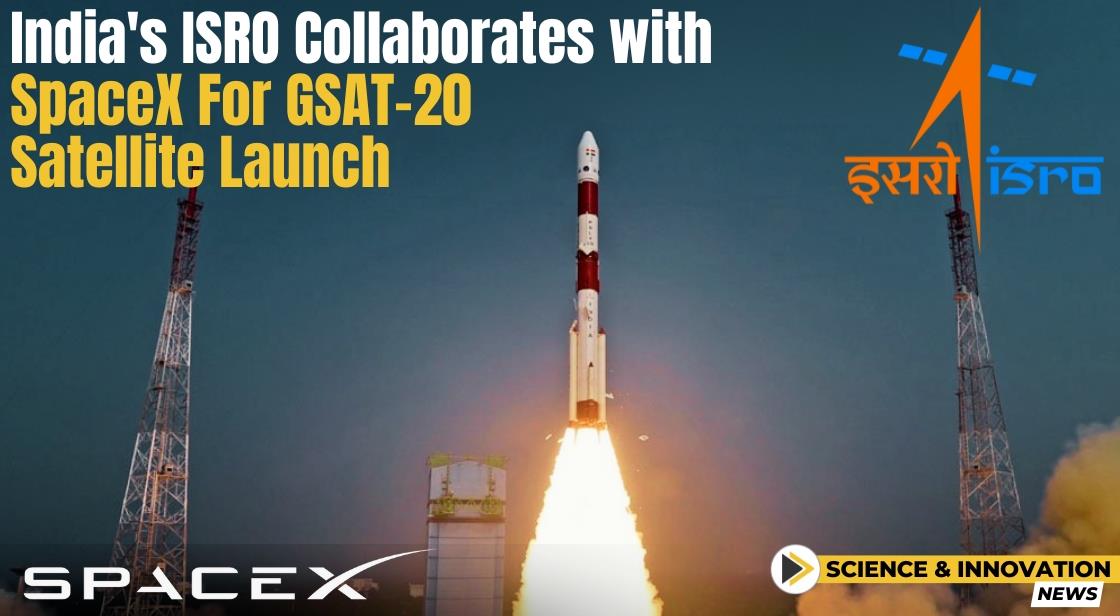India's ISRO Collaborates with SpaceX for GSAT-20 Satellite Launch

News Synopsis
The Indian Space Research Organisation (ISRO) is on the brink of a historic moment with the impending launch of its GSAT-20 communication satellite, weighing a substantial 4,700kg. This venture marks India's foray into a new era of satellite technology, positioning it as a significant player in the global space exploration arena.
Notably, to facilitate this launch, ISRO has engaged in a groundbreaking collaboration with Elon Musk's SpaceX, leveraging the capabilities of the Falcon-9 rocket. The launch is scheduled for the second quarter of 2024, symbolizing a noteworthy partnership between India and SpaceX in the realm of space exploration.
GSAT-20: A Technological Marvel
While ISRO is actively developing a rocket with the capacity to lift payloads exceeding four tons, the GSAT-20 launch showcases India's innovative strides in satellite technology. The satellite is designed to weigh 700kg beyond the maximum capacity of ISRO's current flagship rocket, the LVM3.
GSAT-20 is a testament to Indian technological prowess, intending to provide cost-effective Ka-Ka band high throughput satellite (HTS) services. These services primarily target broadband connectivity, IFMC, and cellular backhaul service needs, with a focus on serving remote and unconnected regions.
Falcon-9 Rockets for Indian Milestones
ISRO's collaboration with SpaceX for the GSAT-20 launch underscores India's quest for cost-efficient solutions beyond its own capabilities. While the LVM3 rocket has served admirably, its limitations have prompted ISRO to explore strategic partnerships.
The GSAT-20, utilizing SpaceX's Falcon-9, signifies India's commitment to ensuring the seamless launch of high-capacity satellites.
GSAT-20's Reach and Capacity
With 32 beams covering Pan-India, including remote territories like Andaman and Nicobar and Lakshadweep islands, GSAT-20 aims for extensive coverage. National Space Institute Limited (NSIL) has confirmed securing the bulk of the HTS capacity on GSAT-20 for Indian service providers, although the specific customers remain undisclosed.
The satellite boasts a remarkable HTS capacity of nearly 48gbps, tailored to meet the demanding service requirements of far-flung regions.
ISRO's Pursuit of Advancements
While GSAT-20 takes advantage of SpaceX's capabilities, ISRO remains steadfast in its commitment to enhancing indigenous capabilities. The agency is actively working on its semi-cryogenic engine, a pivotal component for rockets carrying payloads beyond four tons. ISRO is gearing up for a crucial test of the semi-cryogenic engine, incorporating a propellant combination of Liquid Oxygen (LOX) and Kerosene, signaling its aspirations for future rockets.
Setback and Resilience
ISRO encountered a setback in July 2023 during the first hot test of the semi-cryogenic engine. Conducted at the ISRO Propulsion Complex (IPRC) in Tamil Nadu, the test faced unforeseen challenges, including a spike in turbine pressure and a subsequent loss of turbine speed, resulting in the test's termination.
Beyond Collaboration: Fostering Self-Reliance:
-
Cost-Effective Choice: While opting for SpaceX offers immediate launch solutions, ISRO remains dedicated to indigenous rocket development. Its focus lies on perfecting the semi-cryogenic engine, essential for propelling payloads exceeding four tons.
-
Testing Times for Semi-Cryo Engine: A hot test conducted in July 2023 encountered an unforeseen issue, necessitating further refinements. However, ISRO remains undeterred, aiming for another crucial test later this year.
-
Fueling the Future: The semi-cryogenic engine, utilizing the LOX-Kerosene propellant combination, holds the key to powering future generations of ISRO rockets, driving India's self-reliance in space exploration.
You May Like









